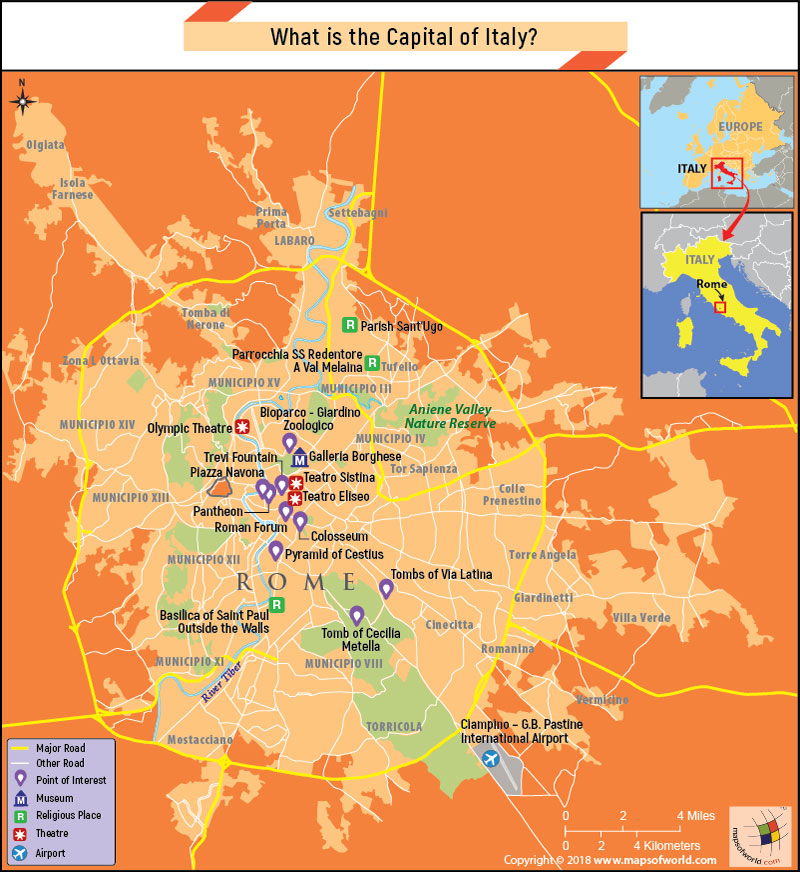What is Italy’s Capital?

Italy, a land of art, culture, and historical splendor, captivates the world with its timeless charm. In this article, we will learn about Italy’s capital, its historical journey, the previous capitals of Italy, the very first and more.
Capital of Italy
Rome is the capital of Italy. It is an ancient city comprising a history spanning back many centuries. It is stated to be the oldest continuously occupied site in Europe. The following centuries witnessed the emergence of Rome as the most important city in the world.
Initially, as the capital of the Roman Kingdom, and then the Roman Republic and the Roman Empire, Rome became a great center of trade, commerce, culture, and political power. The city witnessed a period of decline following the fall of the Roman Empire around 476 AD.
The end of the Roman Empire is also considered to be the beginning of the medieval ages. With the end of the Empire, the Papacy gained control of the city and by the 8th century, Rome had become the capital of the Papal States. In 1861, the Kingdom of Italy was established and by 1870 the Papal States had dissolved.
Fun Fact
It’s interesting to know that Rome officially became the capital in the law only in 2001. This happened with the reform of Title V of the Italian Constitution.
Where is Rome
Rome is situated in the central-western part of the Italian Peninsula and is the most populated commune in Italy. It is surrounded by beautiful hills and strategically placed near the Tyrrhenian Sea to the west, Rome’s location has been really important in making it Italy’s capital.
How Old is Rome
According to traditional legend, the city was founded on April 21, 753 BCE, by the twins Romulus and Remus, but some people aren’t sure about that exact date. Archaeologists think Rome goes back to around the 8th century BCE. It’s one of the oldest cities in Europe that people have been living in for a very long time.
When Rome Became the Capital of Italy
The turning point in Italy’s history unfolded in 1871 when Rome officially became the Italian capital. This was a big deal because it marked the end of a complex time called the Risorgimento, where Italy was figuring out how to come together politically.
Rome becoming the capital wasn’t just a symbol, it was like a smart move to bring all of Italy together in one place after they had united. Rome’s rich history, cultural significance, and central location solidified its position as the heart of the newly unified nation.
Why was Rome Chosen as the Italian Capital
Rome was chosen as the capital of Italy because of the following reasons:
- Historical Significance: Rome was really important in the past because it was the center of the Roman Empire. People wanted to bring back those good times, so they chose Rome as the capital, hoping it would remind everyone of the great things that happened before.
- Cultural Weight: Rome has lots of beautiful art and amazing buildings like the Colosseum and the Trevi Fountain. These things show off Italy’s culture and history, making people feel connected and proud
- Central Location: Rome is right in the center of Italy. It offered a strategic position for the newly formed government, ensuring better administrative control and accessibility.
- Religious Influence: The presence of the Pope within Rome added another layer of significance, symbolizing a connection to the past and a bridge to the future.
Former Capitals of Italy
-
Turin (Torino)
- Period as Capital – 1861-1865
- Significance – Turin was the first capital of the newly unified Kingdom of Italy after the country’s unification in 1861.
- Historical Context – Choosing Turin as the first capital was a smart move because it was not just any city. It was really important in history. Turin played a big role in helping Italy become one country. So, they thought it was a good place to start as the capital.
-
Florence (Firenze)
- Period as Capital – 1865-1871
- Significance – Florence became the capital after Turin and held this status for a short period.
- Historical Context – Florence was the capital for a while because of its rich Renaissance history and cultural heritage. Florence served as the capital during a crucial phase in Italy’s early post-unification years.
Related Maps
